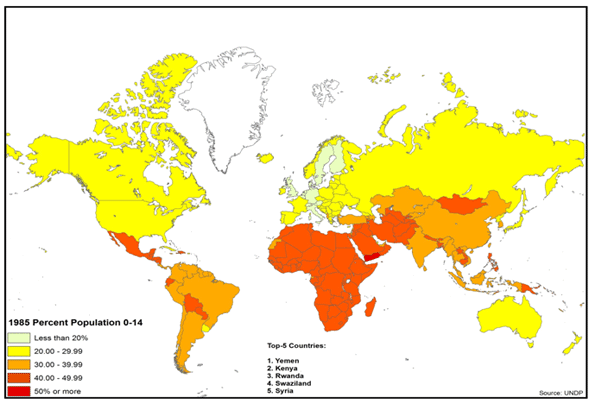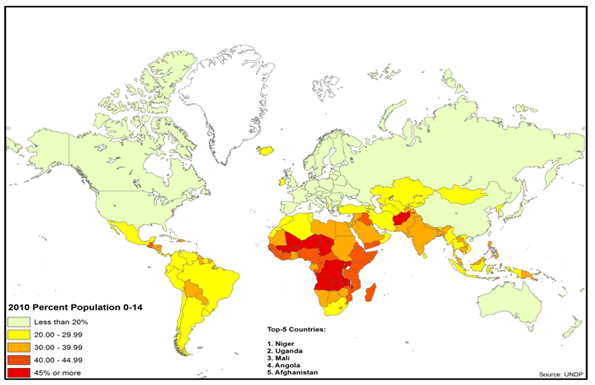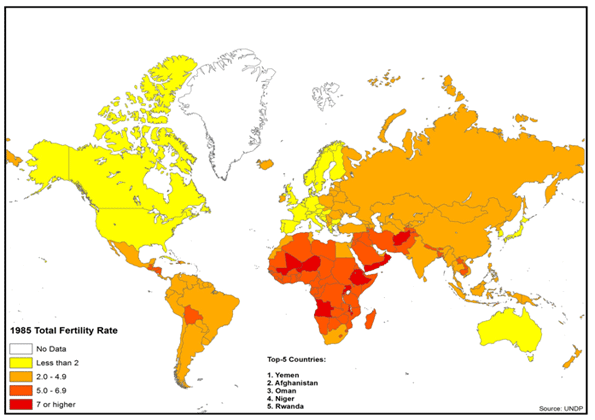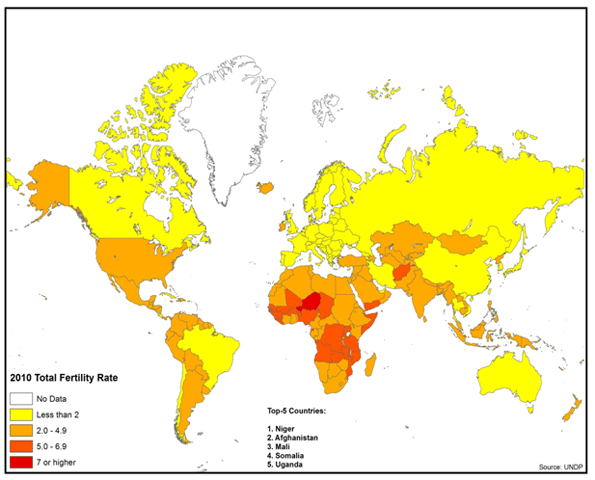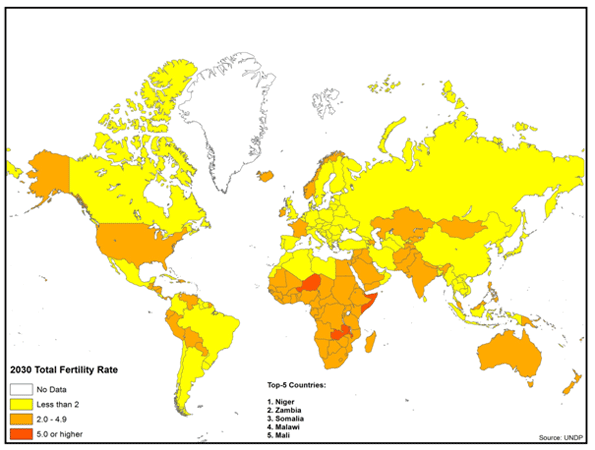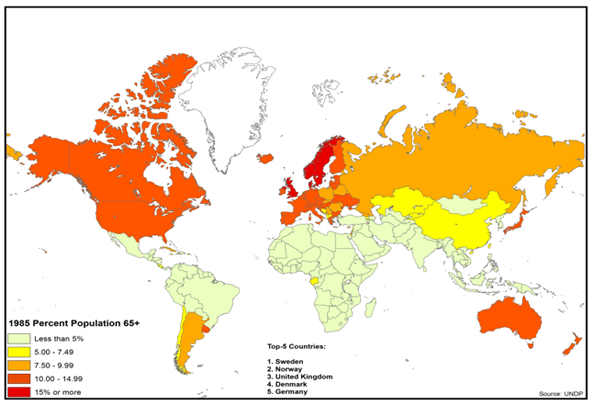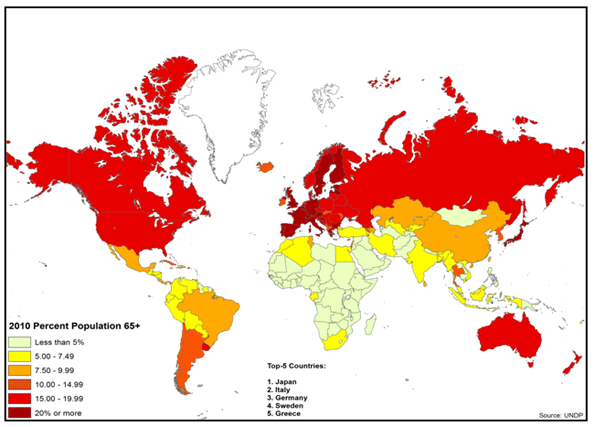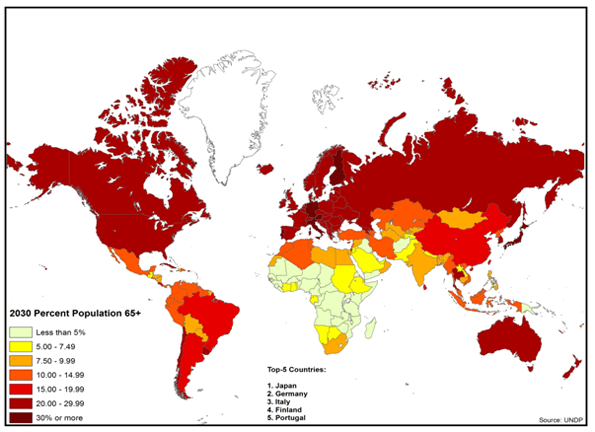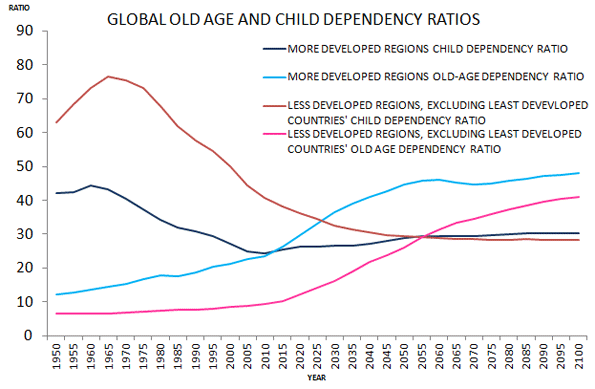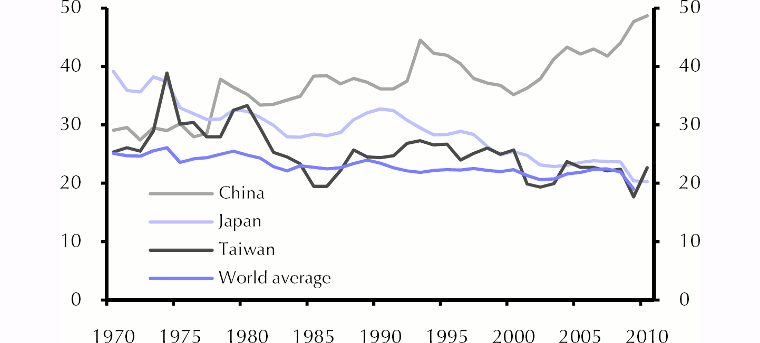How sad this is and what a stunning reversal and an ominous trend for the U.S.A. Washington D.C. now has the highest median household income. This is a city that produces no wealth, no goods and no innovation. The city only exists to make rules and regulations that destroy and confiscate the wealth of others. If ever there was a clearer signal of how off track the U.S. has become I would be surprised.
Washington DC Has Highest Median Household Income, As Wall Street Moved to K Street. OKS?
Political Capital Is Now Richer Than Tech Capital
BLOOMBERG -- "Federal employees whose compensation averages more than $126,000 and the nation’s greatest concentration of lawyers helped Washington edge out San Jose as the wealthiest U.S. metropolitan area, government data show.
The U.S. capital has swapped top spots with Silicon Valley, according to recent Census Bureau figures, with the typical household in the Washington metro area earning $84,523 last year. The national median income for 2010 was $50,046.
The figures demonstrate how the nation’s political and financial classes are prospering as the economy struggles with unemployment above 9 percent and thousands of Americans protest in the streets against income disparity, said Kevin Zeese, director of Prosperity Agenda, a Baltimore-based advocacy group trying to narrow the divide between rich and poor.
“There’s a gap that’s isolating Washington from the reality of the rest of the country,” Zeese said. “They just get more and more out of touch."
In recent years Washington has attracted more lobbyists and firms with an interest in the health-care overhaul and financial regulations signed into law by President Barack Obama, according to local business leaders.
“Wall Street has moved to K Street,” said Barbara Lang, president and chief executive officer of the DC Chamber of Commerce, referring to the Washington street that’s home to prominent lobbying firms. 'Those two industries clearly have grown in our city.'"
MP: Considering that Washington has the highest median income in the country thanks to all of the lawyers and lobbyists, and all of the federal employees earning compensation that averaged $126,369 last year, OWS might have the wrong target. After all, it was government housing policies originating in Washington that contributed more significantly to the housing bubble, mortgage meltdown, financial crisis and economic recession than any greed on Wall Street.
Based on a new Gallup Poll (ht: Economix Blog), the American people understand this, and they are more than twice as likely to blame the federal government in Washington (64%) than financial institutions on Wall Street (30%) for the economic problems facing the U.S. How about: Occupy K Street? Or Occupy 1st Street SE?
Thoughts on economics, politics and international relations with the occasional rant about football(soccer) and life.
My Blog List
Thursday, October 20, 2011
Tuesday, October 18, 2011
Faber, Chanos and others on the coming Chinese economic collapse....The interviews.
What I find most incredible about these videos is how in the minority these guys are. I don't know how it could not be more obvious that there is a massive property bubble in China and that the laws of economics cannot be ignored forever. These videos, especially the last one detailing the vast empty cities China has created coupled with the article I mentioned a few posts back about the coming collapse of the Chinese population makes the policy of inflating a massive property bubble to manufacture growth seem two times a loser. If I were long in minerals, materials and consumer goods manufactures banking on China to drive world consumption growth I would cover or get out. As Jim Chanos says, the timing is the difficult part. What is certain in my opinion is that the day of reckoning will come eventually. It always does.
Jim Chanos:
Marc Faber:
Others:
Program on vast empty cities: 64 Million empty apartments..Wow.
Jim Chanos:
Marc Faber:
Others:
Program on vast empty cities: 64 Million empty apartments..Wow.
China's bubble bursting....
Jim Chanos is one of the few people, along with myself, who has consistently made the argument that China is a massive bubble that will burst and that the bursting of the Chinese bubble will be extremely painful. China's bubble is built on massive government manipulation in the Chinese market. China is not a free market and as such huge distortions have been created to ensure GDP growth regardless of the quality and sustainability of that growth. The purpose of such a suicidal economic plan is to serve the political interest of the PRC establishment.
Chanos: China’s hard-landing has already begun China’s bust will be a thousand times worse than Dubai.
Follow link to original article here.
NEW YORK (MarketWatch) — China is heading into an economic storm, and the much-feared hard-landing of the world’s second-largest economy has already started, warned celebrated hedge-fund manager and China-bear Jim Chanos of Kynikos Associates on Monday.
“The numbers are falling faster than we thought,” said Chanos during an exclusive interview with MarketWatch on the sidelines of the 7th Annual New York Value Investing Congress.
“Real estate sales in September and October, which are peak months, fell 40%-60% on-year,” he said.
Chanos also pointed out that Chinese financial and real-estate stocks are down 30% from their peak, while cement and steel prices are declining.
“People are buying into the idea of perpetual growth,” Chanos said. “But they have to ask, ‘Are you really growing?’”
Chanos stressed that investors should understand that there is no bailout without a cost.
“The only way the Chinese government can continue to bail out everyone is to print more money, which will lead to inflation. But people are depositing money [in banks] at below inflation,” the fund manager said.
Chanos had already suggested back in May that there were clear signs of excess supply in China’s commercial real-estate sector.
About 14% of office space in Beijing and 9% in Shanghai was vacant, according to data he cited at the time.
“Western investors must remember that Chinese consumers are not the next big hope,” he said.
1,000 times worse than Dubai
Chanos has consistently said China’s bust will be a thousand times worse than Dubai.
“It’s very hard to let air out of a property bubble without collateral damage,” he said.
Chanos also expressed concerns about the country’s banking sector.
The Chinese economy is adding $2 trillion of new debt every year, and half of that is problematic from day one, he said.
And since only 50% of the problematic debt is recoverable, about $500 billion, or 10% of gross domestic product, is bad debt, he said.
Last week, China’s sovereign-wealth fund bought about $31.5 million worth of stakes in the nation’s “Big Four” lenders — Agricultural Bank of China Ltd. HK:1288 -7.87% CN:601288 +0.38% , Bank of China Ltd. HK:3988 -4.74% CN:601988 +0.33% BACHY +1.53% , Industrial & Commercial Bank of China Ltd. HK:1398 -6.05% CN:601398 +0.48% IDCBF -2.83% , and China Construction Bank HK:939 -4.39% CN:601939 +0.22% CICHF 0.00% . See report on China’s purchase of banking shares.
The move is a likely indication of which banks the Chinese authorities are worried about, according to Chanos.
In his earlier presentation at Monday’s conference, he cautioned Western investors to remember that politics are a big part of business in China, and that in effect, banks are instruments of state policy.
He also reiterated the message that the house always wins when it comes to foreign investors and China. Remember how they treat Western investors, he said.
“History has not been on our side,” he said.
During the interview, he briefly revisited that particular theme. “Corruption is endemic there. Contracts are meaningless,” Chanos said.
Sue Chang is a MarketWatch reporter in San Francisco.
Chanos: China’s hard-landing has already begun China’s bust will be a thousand times worse than Dubai.
Follow link to original article here.
NEW YORK (MarketWatch) — China is heading into an economic storm, and the much-feared hard-landing of the world’s second-largest economy has already started, warned celebrated hedge-fund manager and China-bear Jim Chanos of Kynikos Associates on Monday.
“The numbers are falling faster than we thought,” said Chanos during an exclusive interview with MarketWatch on the sidelines of the 7th Annual New York Value Investing Congress.
“Real estate sales in September and October, which are peak months, fell 40%-60% on-year,” he said.
Chanos also pointed out that Chinese financial and real-estate stocks are down 30% from their peak, while cement and steel prices are declining.
“People are buying into the idea of perpetual growth,” Chanos said. “But they have to ask, ‘Are you really growing?’”
Chanos stressed that investors should understand that there is no bailout without a cost.
“The only way the Chinese government can continue to bail out everyone is to print more money, which will lead to inflation. But people are depositing money [in banks] at below inflation,” the fund manager said.
Chanos had already suggested back in May that there were clear signs of excess supply in China’s commercial real-estate sector.
About 14% of office space in Beijing and 9% in Shanghai was vacant, according to data he cited at the time.
“Western investors must remember that Chinese consumers are not the next big hope,” he said.
1,000 times worse than Dubai
Chanos has consistently said China’s bust will be a thousand times worse than Dubai.
“It’s very hard to let air out of a property bubble without collateral damage,” he said.
Chanos also expressed concerns about the country’s banking sector.
The Chinese economy is adding $2 trillion of new debt every year, and half of that is problematic from day one, he said.
And since only 50% of the problematic debt is recoverable, about $500 billion, or 10% of gross domestic product, is bad debt, he said.
Last week, China’s sovereign-wealth fund bought about $31.5 million worth of stakes in the nation’s “Big Four” lenders — Agricultural Bank of China Ltd. HK:1288 -7.87% CN:601288 +0.38% , Bank of China Ltd. HK:3988 -4.74% CN:601988 +0.33% BACHY +1.53% , Industrial & Commercial Bank of China Ltd. HK:1398 -6.05% CN:601398 +0.48% IDCBF -2.83% , and China Construction Bank HK:939 -4.39% CN:601939 +0.22% CICHF 0.00% . See report on China’s purchase of banking shares.
The move is a likely indication of which banks the Chinese authorities are worried about, according to Chanos.
In his earlier presentation at Monday’s conference, he cautioned Western investors to remember that politics are a big part of business in China, and that in effect, banks are instruments of state policy.
He also reiterated the message that the house always wins when it comes to foreign investors and China. Remember how they treat Western investors, he said.
“History has not been on our side,” he said.
During the interview, he briefly revisited that particular theme. “Corruption is endemic there. Contracts are meaningless,” Chanos said.
Sue Chang is a MarketWatch reporter in San Francisco.
Monday, October 17, 2011
New Obama 2012 Campaign Ad
I love this. It took me a minute to figure out that it was a parody. For the first minute I just thought it was another example of Obama's incompetence. Great ad and one that needs far more visibility.
This debunks one of the common myths spread by the left that government spending creates jobs and wealth. The other myth this debunks is the myth that by working with the Democratic party in a bi-partisan way the GOP can solve the budget deficit issues. The Dems are 100% committed to ever higher government spending and taxes. The GOP, if they are going to get serious about eliminating the deficits and debt needs to take a page from the Dem's playbook and go all in, should the GOP takes all houses of government in 2012. There can be no moderation. The GOP strategy must be to pursue as deep a root and branch overhaul of the federal government as possible in the time given by voters. The GOP must smash the levers of Democratic power as expressed through federal agencies, bureaucracies, institutions and the tax code.
The federal agencies that must be disbanded include; EPA, Dept. of Education, Dept. of Energy and the NLRB.
The institutions that must be changed through reforms/elimination of government programs include the whole institution of publicly funded higher education. We must put a price on the risk of a particular degree so that we end the proliferation of "studies" degrees and get students again focused on degrees that are both productive to society and good for their future earnings. The best way to do this is to get the government out of the business of funding public education through loans and allow private businesses to place a risk premium on particular degrees based upon past employment/earnings performance.
The tax code must be flattened as to ensure that all citizens have skin in the game and thus pay a price for now "free" government services. A flat tax would also do away with politicians favorite form of rewarding friends and punishing enemies. It would also serve the purpose of getting the government out of the business of providing economy distorting subsidies for preferential behavior. The government has no business deciding what is preferential behavior and certainly no business awarding my income to those it deems appropriate.
The combination of the above approaches would actually solve the budget deficit by dramatically lowering spending and because of the elimination of the tremendous regulatory burdens currently placed on the private sector, growth would explode and revenue would rise allowing the debt to be paid down quickly.
Read original article here.
The Austerity Myth: Federal Spending Up 5% This Year
By JOHN MERLINE, INVESTOR'S BUSINESS DAILY
Posted 08:05 AM ET
When Republicans took control of the House in January, they pledged to make deep cuts in federal spending, and in April they succeeded in passing a bill advertised as cutting $38 billion from fiscal 2011's budget. Then in August, they pushed for a deal to cut an additional $2.4 trillion over the next decade.
Some analysts have blamed these spending cuts for this year's economic slowdown.
But data released by the Treasury Department on Friday show that, so far, there haven't been any spending cuts at all.
Higher Spending, Deficits
In fact, in the first nine months of this year, federal spending was $120 billion higher than in the same period in 2010, the data show. That's an increase of almost 5%. And deficits during this time were $23.5 billion higher.
These spending hikes haven't stopped many analysts from claiming that the country is in an age of budget austerity, one that's hurting economic growth.
A July article in USA Today, for example, claimed that "Already in 2011, softer government spending has sapped growth."
Jared Bernstein, former chief economic adviser to Vice President Biden, wrote over the summer that "government spending cutbacks have been a large drag on growth in recent quarters and have led to sharp losses in state and local employment."
Economist and New York Times columnist Paul Krugman argued in September that "the turn toward austerity (is) a major factor in our growth slowdown."
If government spending is related to growth, as these and others claim, then the economy presumably should be growing faster, not slower, given the current higher rates of federal outlays.
State Spending Higher Too
Nor does the claim that state governments sharply cut spending stand up well to closer scrutiny.
Overall state spending continued to climb right through the recession, when all money from state general funds and other funds, federal grants and state bonds is combined.
Total state outlays in 2010 were almost 10% higher than in 2008, according to the National Association of State Budget Officers' annual State Expenditure Report.
And general fund spending — which makes up about 40% of total state spending — is expected to climb 5.2% in 2011 and 2.6% next year, according to the association's latest survey.
NASBO says that states were able to sustain spending growth through 2010 only because the federal government was pumping more money in via the $830 billion stimulus, and that these funds are now all but exhausted.
As the survey report notes, the tapering off of the stimulus "combined with a slow recovery in state revenue collections, will continue the tight resource environment for states in fiscal 2012."
Meanwhile, the claim that state and local government jobs have been severely cut is, at the very least, open to some debate.
"We know that the biggest problem that we've had in terms of unemployment over the last several months has not been in the private sector," President Obama said at a recent press briefing. "It's actually been layoffs of teachers and cops and firefighters."
Monthly data from the Bureau of Labor Statistics do show that from December 2007 — when the recession officially started — until the end of 2010, state and local governments shed 221,000 jobs. And they've cut another 234,000 jobs so far this year.
But a separate annual survey from the Census Bureau shows that "full-time-equivalent" state and local employment climbed 200,000 between 2007 and 2010 (the latest year for which these census data are available.) The differences come from the methodologies used.
In any case, even using BLS data, the number of state and local government jobs has fallen just 2.3% since December 2007. That compares with a decline of 5.4% for private-sector jobs.
The federal agencies that must be disbanded include; EPA, Dept. of Education, Dept. of Energy and the NLRB.
The institutions that must be changed through reforms/elimination of government programs include the whole institution of publicly funded higher education. We must put a price on the risk of a particular degree so that we end the proliferation of "studies" degrees and get students again focused on degrees that are both productive to society and good for their future earnings. The best way to do this is to get the government out of the business of funding public education through loans and allow private businesses to place a risk premium on particular degrees based upon past employment/earnings performance.
The tax code must be flattened as to ensure that all citizens have skin in the game and thus pay a price for now "free" government services. A flat tax would also do away with politicians favorite form of rewarding friends and punishing enemies. It would also serve the purpose of getting the government out of the business of providing economy distorting subsidies for preferential behavior. The government has no business deciding what is preferential behavior and certainly no business awarding my income to those it deems appropriate.
The combination of the above approaches would actually solve the budget deficit by dramatically lowering spending and because of the elimination of the tremendous regulatory burdens currently placed on the private sector, growth would explode and revenue would rise allowing the debt to be paid down quickly.
Read original article here.
The Austerity Myth: Federal Spending Up 5% This Year
By JOHN MERLINE, INVESTOR'S BUSINESS DAILY
Posted 08:05 AM ET
When Republicans took control of the House in January, they pledged to make deep cuts in federal spending, and in April they succeeded in passing a bill advertised as cutting $38 billion from fiscal 2011's budget. Then in August, they pushed for a deal to cut an additional $2.4 trillion over the next decade.
Some analysts have blamed these spending cuts for this year's economic slowdown.
But data released by the Treasury Department on Friday show that, so far, there haven't been any spending cuts at all.
Higher Spending, Deficits
In fact, in the first nine months of this year, federal spending was $120 billion higher than in the same period in 2010, the data show. That's an increase of almost 5%. And deficits during this time were $23.5 billion higher.
These spending hikes haven't stopped many analysts from claiming that the country is in an age of budget austerity, one that's hurting economic growth.
A July article in USA Today, for example, claimed that "Already in 2011, softer government spending has sapped growth."
Jared Bernstein, former chief economic adviser to Vice President Biden, wrote over the summer that "government spending cutbacks have been a large drag on growth in recent quarters and have led to sharp losses in state and local employment."
Economist and New York Times columnist Paul Krugman argued in September that "the turn toward austerity (is) a major factor in our growth slowdown."
If government spending is related to growth, as these and others claim, then the economy presumably should be growing faster, not slower, given the current higher rates of federal outlays.
State Spending Higher Too
Nor does the claim that state governments sharply cut spending stand up well to closer scrutiny.
Overall state spending continued to climb right through the recession, when all money from state general funds and other funds, federal grants and state bonds is combined.
Total state outlays in 2010 were almost 10% higher than in 2008, according to the National Association of State Budget Officers' annual State Expenditure Report.
And general fund spending — which makes up about 40% of total state spending — is expected to climb 5.2% in 2011 and 2.6% next year, according to the association's latest survey.
NASBO says that states were able to sustain spending growth through 2010 only because the federal government was pumping more money in via the $830 billion stimulus, and that these funds are now all but exhausted.
As the survey report notes, the tapering off of the stimulus "combined with a slow recovery in state revenue collections, will continue the tight resource environment for states in fiscal 2012."
Meanwhile, the claim that state and local government jobs have been severely cut is, at the very least, open to some debate.
"We know that the biggest problem that we've had in terms of unemployment over the last several months has not been in the private sector," President Obama said at a recent press briefing. "It's actually been layoffs of teachers and cops and firefighters."
Monthly data from the Bureau of Labor Statistics do show that from December 2007 — when the recession officially started — until the end of 2010, state and local governments shed 221,000 jobs. And they've cut another 234,000 jobs so far this year.
But a separate annual survey from the Census Bureau shows that "full-time-equivalent" state and local employment climbed 200,000 between 2007 and 2010 (the latest year for which these census data are available.) The differences come from the methodologies used.
In any case, even using BLS data, the number of state and local government jobs has fallen just 2.3% since December 2007. That compares with a decline of 5.4% for private-sector jobs.
Thursday, October 13, 2011
#OccupyOliveGarden
This started here. This is a parody on the Occupywallstreet protests that I saw a gentleman post on a blog. I have added the graphics and #freesoupsalad&breadsticks4all. Great humor and fantastic political satire.
While I strongly disagree with much of what the Occupywallstreet protesters advocate, I can appreciate their desire to excise their constitutional rights of freedom of expression. I only wish that the protesters acknowledged the value of the freedoms they enjoy and the many sacrifices made to protect them. The U.S. constitution is truly an amazing document and apart from what Erza Klein may think it is not confusing and was written by people who were endowed with equal intelligence to present day man and clearly much more courage. Rather than argue for greater government intervention in their lives the protesters should join those of us who have come to the realization that politics ruins most things it touches and as such the less it touches the better. A limited government is the best path to individual prosperity. This has been proven as there is not one example in history of a government having made all of their citizens rich nor succeeded in eliminating want. Want and greed are human emotions and let us pray that the day never comes when government has grown so large, in the U.S., that it has the power to stamp out emotion in the name of destroying greed and want.
This is why I call on all citizens of this great nation and of those freedom loving citizens of great nations and proud peoples around the world to #OccupyOliveGarden!
While I strongly disagree with much of what the Occupywallstreet protesters advocate, I can appreciate their desire to excise their constitutional rights of freedom of expression. I only wish that the protesters acknowledged the value of the freedoms they enjoy and the many sacrifices made to protect them. The U.S. constitution is truly an amazing document and apart from what Erza Klein may think it is not confusing and was written by people who were endowed with equal intelligence to present day man and clearly much more courage. Rather than argue for greater government intervention in their lives the protesters should join those of us who have come to the realization that politics ruins most things it touches and as such the less it touches the better. A limited government is the best path to individual prosperity. This has been proven as there is not one example in history of a government having made all of their citizens rich nor succeeded in eliminating want. Want and greed are human emotions and let us pray that the day never comes when government has grown so large, in the U.S., that it has the power to stamp out emotion in the name of destroying greed and want.
This is why I call on all citizens of this great nation and of those freedom loving citizens of great nations and proud peoples around the world to #OccupyOliveGarden!
Tuesday, October 11, 2011
Six Adults and One Child in China
Excellent analysis. The picture is becoming increasingly clear that a demographic weapon of mass destruction that will explore in the next 20 years with devastating consequences for those that will come of age when it occurs. I cannot see how my generation will meet these challenges while providing for our kids and our own retirement. The economic and political implications of this coming "gray tsunami" are enormous and poorly understood/planned for. I fear that if substantive change is not immediately implemented with regard to reforming entitlements in the U.S. there will be very few other options than to default on "promises" made to the older generation.
As for the rest of the world, this data shows me that much of the world will likely become wealthier as the pie is distributed among fewer individuals, however, overall growth will likely slow unless there is asset inflation or individual consumption reaches levels not thought possible. This also leads me to believe that we will hear endless stories in the affluent work press about the have nots in the high birthrate countries where due to the pie being sliced ever thinner will likely see average consumption and quality of life fall. This is due mainly to the fact that there is very little capital base in these countries already and thus fewer fixed productive assets with which to generate prosperity. This combination of factors coupled with the growing affluence in low birth rate countries will lead to endless tales of unfairness and inequality in the global trading system. This will likely result in continued resentment and possibly armed conflict/terrorism. This will also likely lead to some form of mineral embargo by mineral exporting, high birthrate countries. This type of embargo would be wise and will likely achieve it's stated aim of spreading affluence more broadly, that is of course, if these countries are governed properly and the wealth is used to increase the overall good rather than stolen to enrich a connected few, which sadly, is likely to be the case.
All said, things will be roughly the same as they are today apart from the principle actors on the global stage potentially being rearranged.
SIX ADULTS AND ONE CHILD IN CHINA
by Emma Chen and Wendell Cox 10/10/2011
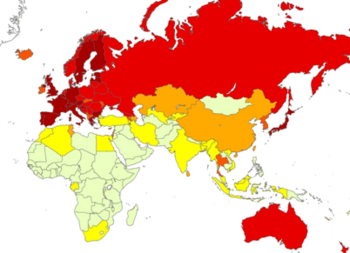
On a Saturday afternoon at The Bund, Xiao Ming (or “Little Ming”) clings tightly onto the hands of his paternal grandparents. His maternal grandparents walk slightly ahead, clearing a path for him in the midst of all the buzz and traffic. Retracing the imprints of their imaginary footsteps, Xiao Ming takes his first tentative steps as a three year old in town for the first time. Slightly behind him, the watchful eyes and ready hands of his own parents spur him on. 1
Xiao Ming’s personal parade epitomises the popular quip in Shanghai and across China, that “it takes six adults to raise one child”. These six individuals form the unspoken support structure of China’s youth: While the OECD points out that 80% of students in Shanghai attend after-school tutoring, it fails to capture the “soft factors” behind Shanghai’s top rankings in the Program for International Student Assessment (PISA). Popular Chinese dramas such as <<房奴>> (House Slave) depict this in meticulous detail: Grandparents spend hours brewing “brain tonics” for their grandchildren, and parents pack austere work lunchboxes to save up for their child’s tuition fees.
LOW FERTILITY AND THE DEMOGRAPHIC DIVIDEND
Fifty-five years ago, China’s fertility rate was 6.1. This had fallen to 1.8 in 2010. This means that in 1955, the typical female in China would have had, on average, six children during her productive life cycle; in 2010 she would have had less than two. If Xiao Ming were born in the 1950s, he would probably have had to vie for attention and resources with at least five other siblings. Today, he has the devoted attention and care of two generations before him. Overall, the number of Chinese under 14 has declined by 6.3 percent over the last decade. (Pierson and David, 2011).
And to be sure there are short and medium term advantages to this situation. These anecdotal observations point to demographic trends that ultimately contribute to the optimal development of a nation’s trajectory. Children may be a blessing, but in many cases too many of them overburden the working population. Indeed some describe this combination of low-fertility with a large workforce as the “demographic dividend” (RAND, 2002).
It is of little surprise that countries with a high Youth Dependency Ratios (children under 15 per 100 persons of working age, or 15 to 64) are less stable, and turn up as hotspots on the world map (Figures 1 & 2). Liberia for instance has a 5.1 percent annual natural population increase rate, 81 children per 100 of working age, and a fertility rate of 4.7. In contrast, prosperous Denmark has a 0.3 percent annual natural population increase rate, 28 children per 100 of working age and a fertility rate of 1.9 (UNDP, 2010).
As population increases outpace economic opportunities and growth, nations at risk fail to accommodate new entrants into the workforce. In addition, caring for children requires a high proportion of resources, thus depressing the rate of economic growth. (Bloom et.al., 2001).
A low median age is thus a harbinger of impending stresses, where in extreme cases at least 50% of the population is below 20 years of age (UNDP, 2010). In comparison, the median age of the developed world averages 30 – 40 years. This forms the foundational basis of several youth bulge studies of late, explaining demographic factors behind the Arab Spring (Anderson, 2011), that was in part driven by massive increase in youth (Hvistendahl, 2011; Fuller, 2003) and the youth workforce (Kuhn and Korbel, 2011; Schwartz, 2011), much of whom are unemployed and underemployed (Bajora, 2011).
THE FERTILITY IMPLOSION
Yet there is a distinct disadvantage as well to ever lower birthrates. Globally population growth rates are likely to continue dropping – to less than 0.8 percent worldwide by 2025 – largely due to an unanticipated drop in birthrates in developing countries such as Mexico and Iran. These declines are in part the result of increased urbanization, the education of women, and higher property prices. Already the global fertility rate, including the developing countries, has dropped in half to an estimated 2.5 today (Longman, 2010a). Close to half the world’s population lives, notes demographer Nicholas Eberstadt, in countries with below replacement rate birth-rates. The world, he suggests, is experiencing a “fertility implosion” (Eberstadt, 2010).
Like a population explosion, a demographic implosion has consequences. Countries that have previously engineered reductions in the fertility rates – Singapore (Yap, 2003), Hong Kong (FPAHK, 2011), Vietnam (Bennett-Jones, 2000), India (WHO, 2011) and Indonesia (Hull, 2007) – have done so to achieve more manageable economic conditions. Similar initiatives are being debated, even in the in the Philippines (Pernia et. al., 2011), where religious interpretations are being contested. China’s “one child policy” represented just a more authoritarian expression of a widespread global process. Yet this process often includes many unintended and potentially damaging consequences. However, elsewhere, virtually the same results were replicated without government policy direction, such as in Brazil (Gomey, 2011).
Chinese “fertility implosion” is already having profound impact on marriage in China. Today researchers characterize declining fertility in China into “waves of singletons” (单身潮). While the first three, distinct “waves” or phases since 1950 are well established (王霞, 2006),it has recently been noted that the fourth (第四次单身潮) is currently in progress(陈亚亚, 2011). In the fourth and current wave, women increasingly view child-bearing and marriage as a form of entrapment and a burden that can interfere with aspirations of affluence (杨燕明 2011; 黄蓉芳 and 杨励潮, 2011).
Not surprisingly this is most evident in the advanced urbanized parts of China, such as Shanghai, where there are already three million people over 60, or 2l percent of the population, roughly equal to the share in many advanced countries (McCartney, 2009).
China now has a fertility rate of 1.6, below that of Western Europe. Nor is China alone. Other middle income nations and even low income nations are experiencing significant declines in fertility rates. Brazil and Iran already have fertility rates less than that of the United States. In Bangladesh and Indonesia, fertility rates are projected to drop below replacement rates (2.1) by 2030. Around the world, increasing affluence has been associated with fewer children, as is indicated in Figures 1 – 3. The longer run implications of these less than replacement fertility rates (2.1) is smaller and much older populations (Figures 3, 4 &5).
GRAYING OF THE WORLD
Here’s the big issue down the historical road: Thirty years from now, how will Xiao Ming handle six elderly parents and grandparents, all by himself? Xiao Ming’s impending dilemma is not unique to China.
Overall what author Phil Longman calls a “gray tsunami” will be sweeping the planet, with more than half of all of population growth coming from people over 60 while only six percent will be from people under 30. The battle of the future – including in the developing world – will be, in large part, how to maintain large enough workforces required for the economic growth needed to, among other things, take care of and feed the elderly (Longman, 2011b). The National Bureau of Research (NBER) further notes that similar to child dependents, a large elderly population similarly requires a large proportion of resources, which likewise can inhibit economic growth (Bloom et. al., 2001).
Right now the situation seems dire. Fertility rates are projected to continue their decline. Increasing life expectancy is contributing to a substantial increase in the elderly population. In many nations, the size of the elderly population will exceed that of the under 15 population for the first time.
This could not have happened at a worse time, because the elderly have become ever more dependent on the state in many nations. Supporting a larger elderly population requires a larger work force, however it will be smaller.
All of this leads to a demographic future that promises to challenge the nations of the world as never before. This is illustrated by rising Old Age Dependency Ratios in Figures 6, 7 & 8.
High income countries are projected to experience elderly population increases on the order of 60 percent in relation to the working age population (15 – 64) by 2030. In the United States, there are now 20 people 65 or over for every 100 of working age; little changed since 1985, when it was 18. However, by 2030 there will be 33 seniors per 100 working people. More extreme will be the fates of the world’s third and fourth largest economies. Germany’s ratio of elderly to working age individuals is already 33, compared to 21 in 1985. In 2030 this ratio will rise to an almost unimaginable 48, meaning that there will be only two working people per retiree. Japan’s situation is even worse. As recently as 1985, Japan had a relatively healthy 15 retirees for every working age person. Today this ratio is one the world’s most extreme: with 35 seniors per 100 working age people. In 2030, this ratio is expected to rise to 53.
Things will be a bit better, at least in the next two decades, in middle income countries such as China and Brazil. But the rate of aging will be even greater than in the high income nations. Both China and Brazil will experience a doubling of their Old Age Dependency Ratios; both will rise slightly above current US levels by 2030. China is projected to rise from 11 to 23, while Brazil’s will increase from 10 to 20. Despite its theological regime, which might be seen as working against smaller families, middle-income Iran is also aging rapidly. It should see a doubling of its Old Age Dependency Ratio, but from a low 7 to a manageable 14.
There will be a mix of results in the lower income countries, as illustrated by the Philippines and Nigeria. In the Philippines, the fertility rate is expected to remain high by current global standards, at 2.6 in 2030, only a modest drop from the present 2.9. However, the elderly will increase 60 percent relative to the working age population (from an Old Age Dependency Ratio of 6 to 10 in 2030). Similarly, in Nigeria the fertility rate is expected to decline only slightly, from 4.8 to 4.5. Alone among the group of nations reviewed, Nigeria is expected to experience only a negligible increase in the Old Age Dependency Ratio, remaining at 6. In 1985, these nations had Old Age Dependency Ratios of between 5 to 7 (UNDP, 2010).
Even if we were to discount population projections going forward (Shahani, 2011), the world is on the verge of a global demographic precipice (Figure 9) – one in which the the increase in proportion of elderly far outweighs that of the increase in proportion of children. A world which Andrew Blechman terms, “a world without children” (Blechman, 2009), and that Ted Fishman describes as one which “pits young against old, child against parent, worker against boss, company against rival, and nation against nation” (Fishman, 2009).
FINANCING THE UNFINANCABLE?
Where there is Virtually Universal State Support.The options available for addressing increasing old age dependency are not very attractive. Older people require considerably more in terms of overall support, particularly for health care, than younger generations (Feinberg et. al., 2011). This is a crisis particularly in demographically declining countries with well-developed social welfare nets. A recent Bank of International Settlements study found that, due to these pressures, Germany’s ratio of public debt to gross domestic product could exceed 200 percent in 2030, with annual debt service approach 10% of GDP. This would be a fiscal burden twice that of Greece today (Eberstadt and Hans, 2010).
Where there is Less State Support: In many nations, state retirement systems often fail to cover a large share of the elderly population. While arrangements vary widely, many elderly must find their own ways to survive, such as by working longer or by relying on families. As emerging nations consider establishing or expanding social safety nets for the elderly, they need to consider the experience of the high-income world welfare states.
Family Support: Given the stresses on public systems, it might be hoped that the elderly could be supported by their children. But this solution has been losing hold throughout the developed world. The mathematics cannot work in any of the challenged nations, at whatever income level: As the elderly population increases relative to the working population, an adult Xiao Ming is unlikely to be able, or willing, to support six parents or grandparents or even two or three.
Reduce Benefits? The accounting answer may be simple – limit elderly benefits to what society can afford. But the politics do not work. Concentrated, organized interests, such as the elderly who receive state benefits, are likely to block any such reforms. The difficulty of dealing with today's challenges, which are modest compared to the future, is illustrated by recent developments in Western Europe and the United States, where recipients of state aid have fought, often successfully, to retain their benefits even in the face of significant funding challenges.
Increase the Birth Rate? A substantial increase in the birth rate in low fertility nations could help, but it would need to happen immediately. This would require broad acceptance of earlier and more frequent child-bearing women, many of whom are increasingly finding a life of affluence to be preferable to one of child-raising. Some projections show increases in the fertility rate in future years, however it could be too little-too late (UNDP HDI, 2010).
More Migration? Increased migration from poorer countries could help richer countries finance the needs of their elderly. However, migration rates are dropping even in the United States, which is by far the world’s largest country for immigration. Although the US foreign born population grew by 10 million over the past decade, both illegal and legal immigration have been dropping. In 2008 there were over one million naturalizations; last year there were barely 600,000, a remarkable 40% drop (Ohlemacher, 2006).
Working Longer: As life expectancy has increased in recent decades, retirement ages have changed little. For example, in the United States, since the establishment of the state retirement system, life expectancy at birth has increased 16 years, while the retirement age has increased only two years. Generally, every additional year in life expectancy is an additional year of state support. One possible solution would be to extend retirement ages beyond the 65 years common in the high income world. Yet while life expectancy has increased, perhaps in 2030, the standard Old Age Development Ratio should be calculated using the population that is more than 75 years old instead of 65.
More Women in the Work Force: Another factor that could assist in meeting the daunting financial challenge of supporting the elderly would be for an increase in female participation in the workplace. The extent to which such an expansion is theoretically possible varies significantly by nation, but this could be part of the solution. There is an important caveat, however. Increasing the supply of workers does not automatically create wealth. Western Europe has had intractable unemployment rates for decades and has been joined in recent years by the United States. More workers, of either sex, will require strong enough economic growth to generate sufficiently high paid employment.
Affordable Housing:One reason for lower birthrates may be the cost of housing. Many of the countries, and regions, with the most expensive housing also tend to experience the lowest fertility – Taiwan, Singapore, Hong Kong, and much of Western Europe. Across China, for example, it is generally agreed that apartment sales prices are exceedingly high relative to incomes (Pierson, 2011). In a number of places with considerable land for new development, like the United Kingdom, Australia and some metropolitan areas of the United States and Canada, researchers have connected substantially increasing prices and housing shortages with overly-restrictive land use regulation. Any strategy that would encourage greater fertility might need to address this issue. Further, the artificially higher house prices consume discretionary income that could be better put to encouraging economic growth by increasing the demand for other goods and services.
Economic Growth: Economic growth represents the best hope. Chinese-level GDP increases would better position to countries for demographic challenges than the Japanese or European rates of the last two decades. Clearly, economic expansion would ameliorate the pre-occupation with splitting the economic pie. It will also be important to pursue policies that minimize costs for households. If, for example, the cost of housing or food is less, more money will be available for necessary social programs (and there will be less resistance to funding them). In a sense, the difference between laggard and strong economic growth can make a huge difference. For example, economist Bret Swanson has shown that the United States could conquer its well-publicized debt burden with economic growth rates of 4 percent (Swanson, 2011).
This Issue Must be Addressed: No one can accurately predict the future, but it is necessary to focus on the issue of aging and declining fertility. In advanced countries, if the elderly retain their state benefits and economic growth continues to be modest or even stagnant, the pressure on economies will be severe. There will be, to put it simply, less money to go around. Those who primarily fund the state – the working population – will have to pay more and could see material reductions to their standards of living. Central Bankers could yield to the temptation to print enough money to seemingly hyper-inflate away the problem, but that could lead to a lower standard of living for all.
Overall our research suggests several possible solutions, including extending work and careers into the 70s; means tested benefits; greater incentives for having children; and measures to keep housing, and whenever possible, more affordable and family friendly. But the ultimate issue will be maintaining economic growth.
The future of Xiao Ming and billions more will depend upon the result.
Emma Chen is a Senior Strategist at the Centre for Strategic Futures, Singapore. The views expressed within this article are solely her own. Publication does not constitute an endorsement by the Centre for Strategic Futures, Singapore.
Wendell Cox is a consultant specializing in demographics and urban issues, principal of Demographia and a visiting professor at the Conservatoire National des Arts et Metiers in Paris.
This project was supported by the Legatum Institute. Maps designed by Ali Modarres, chairman, Geography Department, California State University, Los Angeles.
REFERENCES
王霞. 2006. “第三次单身潮解析 (Analysis of Youth Single Phenomenon in the Third Bachelor Trend).”中国青年研究(China Youth Study) 2006(12).
杨燕明. 2011. “大家谈中国:第四次单身潮反映家庭婚姻危机 (Everybody Discusses China: Fourth Wave of Singles Reflects Family and Marriage Crises).” BBC News. Accessed September 19, 2011.
http://www.bbc.co.uk/zhongwen/simp/comments_on_china/2011/07/110720_coc_....
陈亚亚. 2011. “都市单身女性的生存状态考察 (Observations on the living status of urban single females).” 华人社会和谐家庭论坛暨第九届全国家庭问题学术研讨会(The Ninth National Conference on Family Issues, The Forum for Chinese Societal Harmony and Family), hosted in Guang Dong, 2011.
黄蓉芳 and 杨励潮. 2011. “中国将迎第四次单身潮 近4%的女性因性取向单身 (China Will Meet its Fourth Wave of Singles - Nearly Four Percent of Females are Single Due to Sexual Orientation).”Xinhua, July 19.
Anderson, Lisa. 2011. “Demystifying the Arab Spring.” Foreign Affairs May/June 2011 2-7.
Bajoria, Jayshree. 2011. “Demographics of Arab Protests.” Council on Foreign Relations. Accessed September 19, 2011. http://www.cfr.org/egypt/demographics-arab-protests/p24096.
Bennett-Jones, Owen. 2000. “Vietnam’s Two-Child Policy.” BBC News. Accessed September 19, 2011. http://news.bbc.co.uk/2/hi/asia-pacific/1011799.stm.
Blechman, Andrew D. 2009. Leisureville: Adventures in a World Without Children. New York: Grove Press.
Bloom, David E., David Canning, and Jaypee Sevilla. 2001. “Economic Growth and the Demographic Transition.” NBER Working Paper Series. Accessed September 19, 2011.http://www.nber.org/papers/w8685.pdf.
Eberstadt, Nicholas, and Hans Groth. 2010, “Time for Demographic Stress Test.” Wall Street Journal, November 27.
Eberstadt, Nicholas. 2010. “The Demographic Future.” Foreign Affairs 89:54-64.
Feinberg, Lynn, Susan C. Reinhard, Ari Houser, and Rita Choula. 2011. “Valuing the Invaluable: 2011 Update – The Growing Contributions and Costs of Family Caregiving.” AARP Public Policy Institute. Accessed September 9, 2011. http://assets.aarp.org/rgcenter/ppi/ltc/i51-caregiving.pdf.
Fishman, Ted. 2010. Shock of Gray. New York: Scribner
Friedman, Benjamin. 2005. The Moral Consequences of Economic Growth. New York: Alfred A. Knopf.
Fuller, Graham E. 2003. “The Youth Factor: The New Demographics of the Middle East and the Implications for U.S. Policy”. Brookings Institute. Accessed September 19, 2011.
http://www.brookings.edu/~/media/Files/rc/papers/2003/06middleeast_fulle....
Gorney, Cynthia. 2011. “Brazil’s Girl Power.” National Geographic, September.
Hvistendahl, M. 2011. “Young and Restless can be a Volatile Mix.” Science 333:552-4.
Hull, Terence H, “Formative Years of Family Planning in Indonesia,” in The Global Family Planning Revolution: Three Decades of Population Policies, edited by Warren C. Robinson and John C. Warren (Washington: The World Bank, 2007), 246.
Kuhn, Randall, and Josef Korbel. 2011. “On the Role of Human Capability in the Arab Spring.” Working paper, University of Colorado Boulder. Accessed September 19, 2011.http://www.colorado.edu/ibs/pubs/pop/pop2011-0011.pdf.
Longman, Phillip. 2010. “Think Again: Global Aging.” Foreign Policy. Accessed September 19, 2011. http://www.foreignpolicy.com/articles/2010/10/11/think_again_global_agin....
Longman, Phillip. 2011. “The World Will be More Crowded – With Old People.” Foreign Policy. Accessed September 19, 2011.http://www.foreignpolicy.com/articles/2011/08/15/the_world_will_be_more_....
McCartney, Jean. 2009. “China Steps Back from One Child Policy.” Times, July 24.
Ohlemacher, Stephen. 2006. “3M a Year Leave Developing Countries.” Associated Press, August 17.
Pernia, Ernesto M., Stella Alabastro-Quimbo, Maria Joy V. Abrenica, Ruperto P. Alonzo, Agustin L. Arcenas, Arsenio M. Balisacan, Dante B. Canlas, Joseph J. Capuno, Ramon L. Clarete, Rolando A. Danao, Emmanuel S. de
Dios, Aleli dela Paz-Kraft, Benjamin E. Diokno, Emmanuel F. Esguerra, Raul V. Fabella, Maria Socorro Gochoco-Bautista, Teresa J. Ho, Dennis Claire S. Mapa, Felipe M. Medalla, Maria Nimfa F. Mendoza, Solita C. Monsod, Toby Melissa C. Monsod, Fidelina Natividad-Carlos, Cayetano W. Paderanga, Gerardo P. Sicat, Orville C. Solon, and Edita A. Tan. 2011. Discussion paper, University of the Philippines. Accessed September 19, 2011.http://www.econ.upd.edu.ph/dp/index.php/dp/article/viewFile/670/132.
Pierson, David. 2011. “In China, Having Children is no Longer a Given.” Los Angeles Times, September 2.
RAND Corporation. 2002. “Banking the ‘Demographic Dividend’.” Accessed September 19, 2011.http://www.rand.org/pubs/research_briefs/RB5065/index1.html.
Shahani, Lila Ramos. 2011. “Whither the RH Bill”. BusinessWorld Online. Accessed 19 September, 2011. http://www.bworldonline.com/content.php?section=Opinion&title=Whither-th...
Schwartz, Stephanie. 2011. “Youth and the ‘Arab Spring’.” United States Institute of Peace. Accessed September 19, 2011. http://www.usip.org/publications/youth-and-the-arab-spring.
Swanson, Bret. 2011. “The Growth Imperative.” Presentation to the National Chamber Foundation, Washington D.C., May 24. Accessed September 19, 2011.http://entropyeconomics.com/wp-content/uploads/2011/05/EE-NCF-Growth-Imp....
The Family Planning Association of Hong Kong. 2011. “Family Planning Milestone.” Accessed September 19, 2011. http://www.famplan.org.hk/fpahk/en/template1.asp?style=template1.asp&con....
United Nations Development Programme. 2010. “International Human Development Indicators.” New York: UN Human Development Report Office. Accessed September 19, 2011.http://hdr.undp.org/en/statistics.
U.S. Department of Homeland Security. 2010. “Table 20 - Petitions for Naturalization Filed, Persons Naturalized, and Petitions for Naturalization Denied: Fiscal Years 1907 to 2010.” Washington D.C.: U.S. Department of Homeland Security. Accessed September 19, 2011.http://www.dhs.gov/files/statistics/publications/YrBk10Na.shtm.
United Nations Development Programme. 2010. “International Human Development Indicators.” New York: UN Human Development Report Office. Accessed September 19, 2011.http://hdr.undp.org/en/statistics.
United Nations Development Programme. 2010. “International Human Development Indicators.” New York: UN Human Development Report Office. Accessed September 19, 2011.http://hdr.undp.org/en/statistics.
United Nations Development Programme. 2010. “International Human Development Indicators.” New York: UN Human Development Report Office. Accessed September 19, 2011.http://hdr.undp.org/en/statistics.
World Health Organization Regional Office for South-East Asia. “India and Family Planning: An Overview.” Accessed September 19, 2011.http://www.searo.who.int/LinkFiles/Family_Planning_Fact_Sheets_india.pdf
Yap, Mui Teng. 2003. “Fertility and Population Policy: The Singapore Experience.” Journal of Population and Social Security (Population) 1:643-58.
|
Monday, October 10, 2011
It begins.
I have been saying for a long time now that China's economic growth was unsustainable. Simply put the laws of economics cannot be ignored forever. The Chinese have done a commendable job leveraging the undervalued Yuan and resulting current account surpluses, when sterilized, provided the government with massive amounts of excess dollar liquidity, to drive growth. This dollar liquidity had to go somewhere and it went into the banks, real estate market and into subsidies to push exports globally. While the policy of state intervention in a free market appears, on the surface, to provide the foundation of sustained growth in China, I have argued that the growth was largely wasteful and that the whole system was likely to collapse. I still believe this to be the case because everything I know about economics tells me that governments are not efficient allocators of capital and that over time the inefficiencies inherent in a state directed capitalist model would grow too large and eventually consume the productive sector leading to a general collapse. The canary in the coal mine foretelling coming doom in an economy is usually the financial system. In this case, the canary is singing loudly and China's day of reckoning may be upon us. The massive build up of bad loans, described on this blog in great detail, coupled with the growing protectionist sentiment around the world and the awakening of the world to China's trade policies and the terribly distorting nature of China's role in the global economic order and you can see that China is headed for a fall and hard.
I recommend all my readers to visit the FT.com site on the current Chinese government bailout of their financial sector. The link to the article is here.
Below is a graph of China's fixed investment ratio...This cannot last.
To put the Chinese figure in perspective, the U.S. investment as a percentage of GDP for 2010 stood at about 15%. Of course, the U.S. need not spend like the Chinese since a solid infrastructure needed for economic growth already exists here.
The pressure for trade barriers will continue to grow as China's share of the U.S. and other countries trade deficits grow. Couple this with the economic stagnation seen in the U.S. and Europe and you have a scenario that is ripe for political intervention. See China's share of U.S. trade deficit below.
I recommend all my readers to visit the FT.com site on the current Chinese government bailout of their financial sector. The link to the article is here.
Below is a graph of China's fixed investment ratio...This cannot last.
To put the Chinese figure in perspective, the U.S. investment as a percentage of GDP for 2010 stood at about 15%. Of course, the U.S. need not spend like the Chinese since a solid infrastructure needed for economic growth already exists here.
The pressure for trade barriers will continue to grow as China's share of the U.S. and other countries trade deficits grow. Couple this with the economic stagnation seen in the U.S. and Europe and you have a scenario that is ripe for political intervention. See China's share of U.S. trade deficit below.
Wednesday, September 28, 2011
Energy Fact of the Week: How Much Green for ‘Green Jobs’?
Pathetic simply pathetic. Yet another example of emotion and hope driving policy rather than fact and logic. In the face of facts that point out that "Green Jobs" are a total bust the Obama administration continues
to pursue a policy of wasting tax payer funds and driving long-term inflation by printing and spending money we do not have. These policies have to end if the U.S. and the western world is to experience a true economic recovery.

Energy Fact of the Week: How Much Green for ‘Green Jobs’?
September 22, 2011, 9:49 amEven without the bankruptcy of Solyndra, the Washington Post noted that the Department of Energy’s entire $38 billion loan guarantee portfolio has generated a total of just 3,545 jobs—rather fewer than the 65,000 jobs the Obama administration projected the program would generate. That’s over $6 million per job. That’s a lot of ’70s-era Steve Austins running around powering the country. Even if the program worked as advertised, Dan Mitchell points out, it would come to about $600,000 per job generated, compared to an average capital cost of about $160,000 per job across the economy as a whole.
This might still not be unreasonable if these green energy jobs generated a lot of energy. In fact, overall electricity-sector investment generates fewer jobs than the average per dollar invested in the general economy. But it doesn’t appear that green energy programs produce jobs or energy in much quantity. A study by Hillard Huntington for Stanford University’s Energy Modeling Forum in 2009 looked at jobs created in different sectors of electricity production, and concluded that:
the advantages of increased jobs from renewable energy are vastly overstated at costs prevailing today … More importantly, strategies that subsidize these investments will be shifting the country’s scarce resources from sectors that would create more jobs (as well as economic value). This conclusion applies even for an economy in a deep recession and where policy wants to stimulate employment. Investments in roads, ground transportation and health care are likely to stimulate employment considerably more than green electric power generation. Policymakers and government agencies should look askance at the claimed additional job benefits from green energy.
Bottom line: “It will require a dramatic break-through in costs if renewable energy is to become a job generator.”
The Huntington study includes a very useful table that shows the final limitation of the green jobs mania. Although $1 million spent on “green” sources such as wind, solar, and biomass will generate slightly more jobs than $1 million spent on coal or natural-gas-fired electricity, the $1 million spent for coal or gas generates far more energy, making coal and gas a much more efficient investment. Figure 1 displays estimates of the number of jobs generated from $1 million in each electricity source, showing that by some estimates renewable sources produce more jobs per $1 million (the difference reflects the range of costs for renewables, which fluctuate wildly). Figure 2 shows the amount of electricity output from $1 million invested in each form. While wind and biomass stack up well with natural gas, coal is still the cheapest, and solar performs very poorly. (Caveat: these figures are based on 2006 prices. The fall in natural gas prices since that time will probably yield a different result today, placing it closer to coal.)
Subscribe to:
Posts (Atom)



